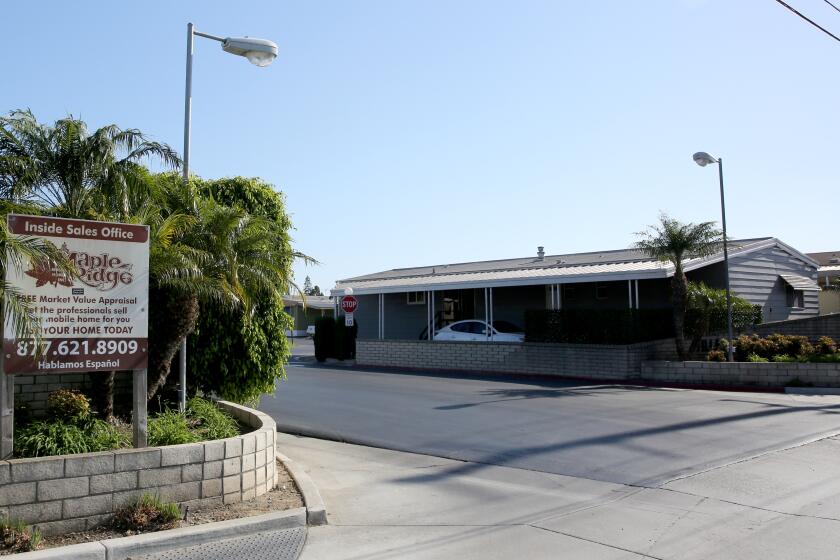A new beginning
- Share via
Alex Coolman
* EDITOR’S NOTE: The following is the last in a four-part series
focusing on the struggles and triumphs of the disabled, their families
and those who live and work with them.
He woke up unable move his arms or his legs.
Just the day before, he had been bodysurfing in the crashing waves of
The Wedge when something went wrong. Now, he was facing the reality of
being quadriplegic.
And, as Hoag Hospital physical therapist Bill Healey recalls the
scene, the young man reacted with anger and impatience, yelling at the
hospital orderlies who were trying to make him comfortable.
“The only thing he could do was move his head and talk, and I think
that was how he tried to be part of the interaction,” Healey said. “I
think it was just an attempt to exert some control” over a situation in
which he was utterly at the mercy of other people.
For the disabled -- whether they have dealt with their disabilities
since birth, or if one day they woke up to confront them, like the young
bodysurfer -- finding a way to live a life that is controlled and
meaningful is a challenge, one that can sometimes be daunting.
What Healey and others who work with the disabled try to stress is
that the challenge is one that can be met -- and one that can be met more
easily today than just a few years ago.
Being disabled means that life is different, Healey said. It no longer
means that life has to be less meaningful.
At the Costa Mesa location of Enriching, an “intermediate care”
facility that serves six disabled clients, the fact that people are in
wheelchairs is regarded not as something abnormal or bizarre, but simply
as a logistic detail to be dealt with.
And Gregg Brown, a 37-year-old man with cerebral palsy, says attitude
makes a major difference in the kind of life he’s able to lead.
“I used to live in the Fairview Developmental Center,” a more
institutional setting that didn’t allow him to interact with the
community, Brown said.
Today, however, Brown has a job and is something of a Costa Mesa
gadfly. Though he is dependent on an electric wheelchair and has very
limited mobility, he’s been able to lobby the City Council for improved
handicapped access on area streets.
Jeff Pfeiffer, 45, also has cerebral palsy. It’s hard for him to speak
and he uses a wheelchair to get around. But Pfeiffer is bright, energetic
and motivated. He works at Calvary Chapel doing quality assurance for the
church’s audiotapes and is taking algebra and astronomy courses at Orange
Coast College.
It’s not as though life has suddenly become easy for the disabled.
Cathy Hilterbran, a 28-year-old woman with cerebral palsy, says she is
sometimes frustrated by buses that don’t stop for her in her wheelchair,
and by the fearful reactions of people who have never dealt with someone
in her situation.
But Hilterbran says positive reactions are more common than they used
to be, in part because disabled people are now more visible in society.
She works at OCC’s day-care center as a volunteer and says most of the
children -- not all of them, but most of them -- are able to see the
strength and generosity beneath her physical limitations.
“Every kid is different, I’ve found out,” she said. “If they don’t
take to me right away, eventually they will.”
Linda Smith, director of the Family Support Network, a Santa Ana
organization that provides assistance to the families of children with
disabilities, said visibility -- of people with developmental
difficulties, of people in wheelchairs, of people who have to struggle
with debilitating injuries -- has been a key factor in making life better
for those whose bodies don’t conform to what society views as normal.
“Inclusion has changed lives,” she said. “I don’t think it’s a stigma”
to be disabled anymore. “I think having a disability is part of who that
person is.”
At Hoag, Healey helps victims of strokes and accidents to recover
mobility. Often it begins with simply trying to determine the nature of
the patient’s physical damage.
“You can only move a little bit here,” he might tell a patient. “And
based on how you are today, because you can’t feel your arm and leg, I’m
going to ask you to be looking more to your side. I’m going to show you
how to get into and out of a wheelchair until your walking improves.”
It doesn’t mean a patient’s life is over, he said.
It means the fight for a new, different life is just beginning.
All the latest on Orange County from Orange County.
Get our free TimesOC newsletter.
You may occasionally receive promotional content from the Daily Pilot.









